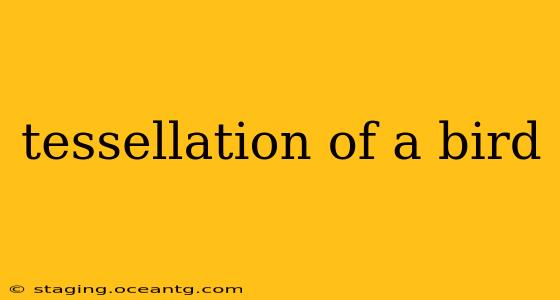Tessellations, the art of covering a surface with repeating shapes without gaps or overlaps, offer a fascinating lens through which to view the natural world. While geometric shapes like squares and hexagons readily lend themselves to tessellation, the intricate forms of birds present a unique challenge and a rewarding artistic exploration. This article delves into the fascinating world of tessellating birds, exploring the techniques, challenges, and artistic interpretations involved.
What is a Tessellation?
Before we dive into the avian aspects, let's clarify what a tessellation is. A tessellation, also known as a tiling, is a pattern formed by repeating a geometric shape to cover a plane without any gaps or overlaps. Think of honeycombs (hexagonal tessellations) or the tiles on a bathroom floor (often square or rectangular tessellations). The challenge with tessellating organic forms like birds lies in adapting their irregular shapes to fit together seamlessly.
Can You Tessellate a Bird? The Challenges and Techniques
Tessellating a bird requires manipulating the bird's shape to create a repeating unit that fits perfectly alongside others. This isn't simply tracing and copying; it requires understanding the principles of tessellation and employing specific techniques. The irregular shape of a bird, with its wings, beak, and tail, necessitates modifications to create a repeating pattern. This often involves:
- Shape Simplification: Reducing the complexity of the bird's form. This might involve smoothing curves, simplifying details, or focusing on a stylized representation.
- Translation: Simply sliding the bird's shape repeatedly across the plane. This is the simplest form of tessellation, but it rarely works well with complex shapes like birds without significant modification.
- Rotation: Rotating the bird's shape at specific angles to create a fitting pattern.
- Reflection: Mirroring the bird's shape to create symmetry and improve the fit.
- Combination of Techniques: Often, a successful avian tessellation involves a combination of translation, rotation, and reflection to achieve a seamless pattern.
How Are Birds Adapted for Tessellation?
While a realistic bird image isn't easily tesselated, stylized representations are far more adaptable. Artists often simplify the bird's form, emphasizing its silhouette and utilizing geometric shapes to create a tessellating unit. This simplification allows for the application of traditional tessellation techniques, leading to visually appealing results.
What are Some Examples of Bird Tessellations?
Many artists have explored the challenge and beauty of bird tessellations. You'll find examples ranging from intricate, highly detailed patterns to simpler, more graphic designs. Search online for "bird tessellation art" to find a wide variety of styles and techniques. The use of color and pattern within the tessellation further enhances the artistic effect.
What Software Can I Use to Create a Bird Tessellation?
Several software programs can assist in creating bird tessellations. Vector graphics editors like Adobe Illustrator or Inkscape offer tools for precise shape manipulation and pattern creation. You can also find dedicated tessellation software or even use programming languages like Python to generate complex tessellation patterns.
What are the Applications of Bird Tessellations?
Beyond their artistic merit, bird tessellations find applications in various areas:
- Textile Design: Tessellated bird patterns are frequently used in fabric design for clothing, home decor, and more.
- Graphic Design: They can add a unique visual element to posters, logos, and other graphic designs.
- Wall Murals and Tiles: Bird tessellations can create striking and eye-catching wall art or tiled surfaces.
Conclusion: Soaring into the Art of Avian Geometry
Tessellating a bird presents a unique artistic and mathematical challenge. By understanding the principles of tessellation and employing creative techniques, artists can transform the seemingly irregular shapes of birds into beautiful, repeating patterns. Whether simplified or stylized, the result is a testament to the interplay between nature's forms and the rules of geometry. The continued exploration of this fascinating field promises further innovation and artistic expression.
